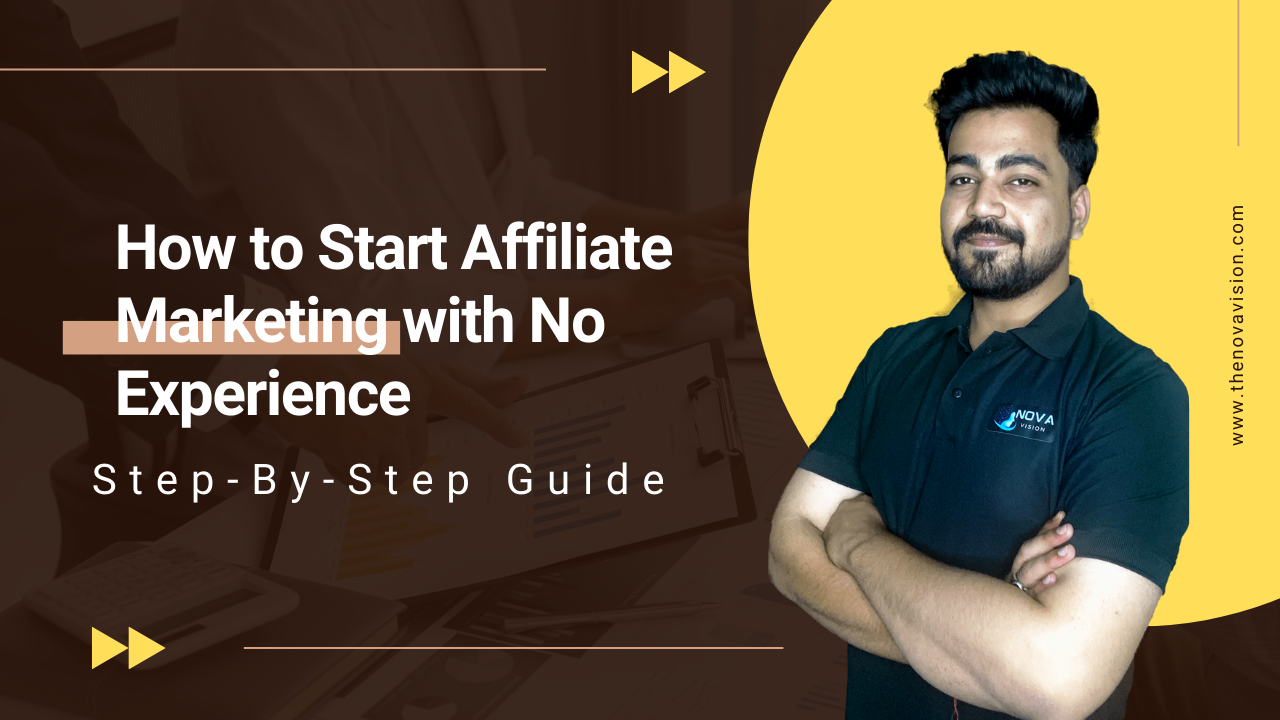
How to Start Affiliate Marketing with No Experience: A Step-by-Step Guide
Affiliate marketing is a performance-based online marketing model where individuals, known as affiliates, earn commissions by promoting other companies’ products or services. Instead of selling your own products, you partner with brands and drive sales through unique tracking links. When a customer makes a purchase using your affiliate link, you receive a commission.
How Affiliate Marketing Works – Step-by-Step Process
- Join an Affiliate Program – Sign up for a company’s affiliate program (Amazon Associates, ShareASale, CJ Affiliate, etc.).
- Get Your Unique Affiliate Link – Each affiliate receives a unique link to track referrals.
- Promote the Product – Share your link via blogs, social media, YouTube, email marketing, or paid ads.
- Customer Clicks the Link – A potential buyer clicks your link, leading them to the merchant’s website.
- Customer Makes a Purchase – If they buy, the merchant records the sale under your referral.
- You Earn a Commission – The company pays you a percentage of the sale.
Illustration: Affiliate Marketing Workflow
Fun Fact:
The global affiliate marketing industry is currently valued at over $12 billion and continues to grow as businesses shift to online sales. (Source: Statista)
Why is Affiliate Marketing a Great Business Model?
Affiliate marketing is one of the easiest and most accessible online income streams due to its many advantages:
No Inventory Required – No need to stock or ship products; the merchant handles everything.
Low Initial Investment – Many affiliate programs allow free sign-ups, requiring minimal startup costs.
Passive Income Potential – Once your content ranks or gains traction, you can earn commissions 24/7.
Scalable – As you build an audience, your earnings can increase exponentially.
Flexible Work Model – You can work from anywhere and promote multiple products across different niches.
Affiliate Marketing Earnings Potential
Affiliate Strategy | Earnings Potential (Per Month) |
Blogging | $500 – $10,000 |
YouTube Reviews | $1,000 – $20,000 |
Email Marketing | $500 – $50,000 |
Social Media Promotions | $100 – $5,000 |
Paid Advertising | $500 – $15,000 |
Affiliate marketing offers a lucrative, low-risk way to generate income, making it one of the best online business models for beginners and professionals alike.
The best part? You can start with zero investment, no prior experience, and minimal risk. Many affiliate programs allow you to sign up for free and provide the necessary promotional materials, making it an ideal choice for beginners looking to earn passive income online.
How Does Affiliate Marketing Work?
Affiliate marketing operates through a simple process:
- You join an affiliate program – Companies or networks provide unique tracking links.
- You promote the product – Share the link through blogs, websites, social media, or videos.
- A customer makes a purchase – When someone clicks your link and buys the product, a commission is credited to you.
- You earn money – The company tracks sales through your affiliate ID and pays you accordingly.
Key Benefits of Affiliate Marketing
Low Startup Costs – No need to invest in inventory or production.
No Need for a Physical Store – You can work from anywhere with an internet connection.
Passive Income Potential – Earn while you sleep as people buy through your links.
Scalability – As your audience grows, your earnings can multiply.
Flexibility – Promote multiple products and earn from different sources.
Affiliate Marketing Business Model Diagram
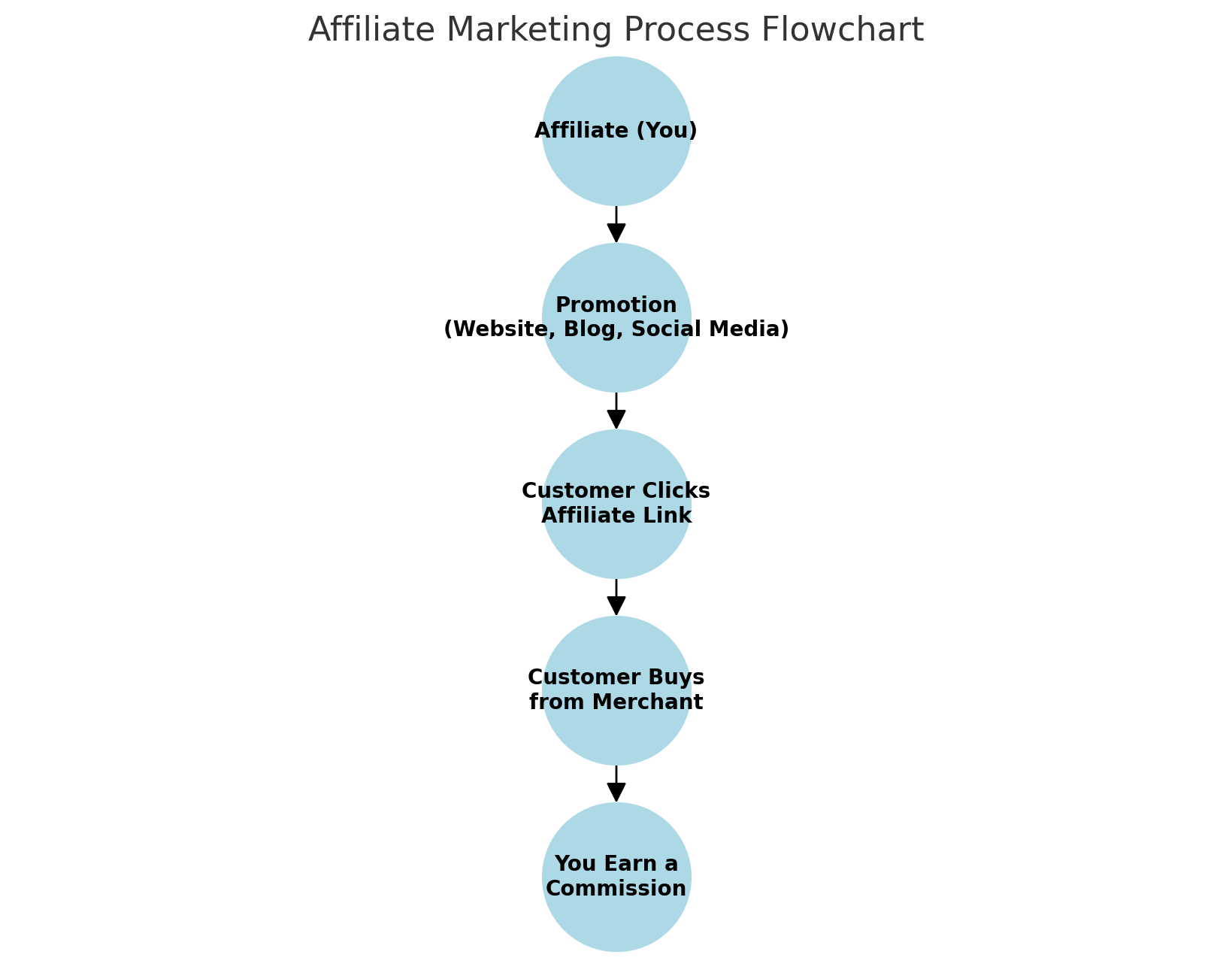
Growth of the Affiliate Marketing Industry
The affiliate marketing industry is experiencing exponential growth, with more companies leveraging this model as a cost-effective strategy to drive sales. The rapid expansion of e-commerce and digital platforms has further fueled this growth, making it an increasingly popular choice for businesses and marketers alike.
Key Drivers of Growth:
- Shift to Online Shopping – The rise of e-commerce has created a vast marketplace for affiliate marketers.
- Increased Digital Advertising Spend – Companies are investing more in online ads, with affiliate marketing being a major part of their strategy.
- Growth of Influencer Marketing – Social media influencers and content creators are increasingly leveraging affiliate marketing to monetize their audience.
- Advancements in Tracking & AI – Modern tools and AI-driven analytics make it easier to track commissions and optimize affiliate campaigns.
- Global Market Expansion – More companies are launching international affiliate programs, offering global earning opportunities.
Statistical Growth Trends
- In 2015, the affiliate marketing industry was valued at $4.8 billion.
- By 2022, it had grown to over $12 billion.
- Experts predict that by 2027, the industry will surpass $20 billion, driven by technological advancements and higher internet penetration rates.
Affiliate Marketing’s Role in E-Commerce
Affiliate marketing is now responsible for generating 16% of all e-commerce sales worldwide, making it one of the most important channels for online businesses. Companies such as Amazon, Walmart, and Shopify heavily rely on affiliate marketers to expand their reach and drive sales without upfront advertising costs.
Why Now is the Best Time to Start?
🔹Low Competition in Emerging Niches – While some sectors are saturated, there are many untapped markets.
🔹 More High-Paying Affiliate Programs – Companies are offering higher commissions to attract top affiliates.
🔹 AI-Powered Marketing Tools – AI-driven SEO, content generation, and analytics make it easier to optimize campaigns.
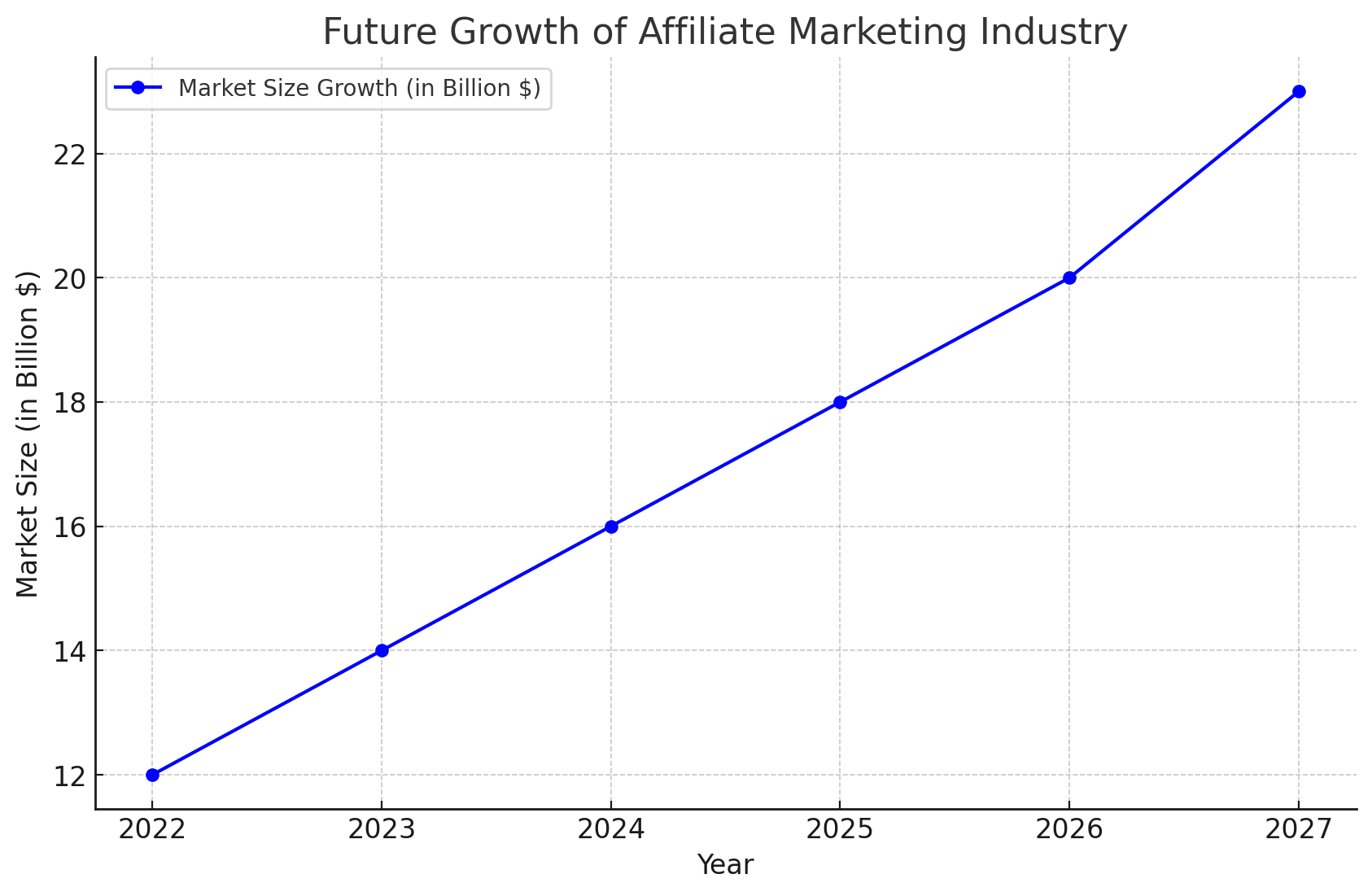
With such promising opportunities, now is the best time to start your affiliate marketing journey. By getting in early, you can build authority in your niche and establish a strong income stream for years to come.
Step 1: Understanding How Affiliate Marketing Works
Before you start your affiliate marketing journey, it’s important to understand the four key parties involved in the process:
1. Affiliate (You)
The affiliate is the individual who promotes products or services of a company and earns a commission for each sale or action generated through their unique referral link. Affiliates can use various platforms such as blogs, social media, YouTube, and email marketing to drive traffic and generate sales.
Your role as an affiliate:
- Select a niche that aligns with your interests or expertise.
- Join affiliate programs related to your niche.
- Create valuable content (blogs, videos, social media posts) that encourages potential customers to make a purchase.
- Drive traffic to your affiliate links using SEO, paid ads, and organic promotion.
2. Merchant (Company)
The merchant is the business or company that creates and sells the product or service. Merchants benefit from affiliate marketing by expanding their reach and increasing sales without spending on traditional advertising. Popular merchants include brands like Amazon, Shopify, Bluehost, and Nike.
What merchants provide to affiliates:
- A structured affiliate program with commission details.
- Unique tracking links to measure affiliate performance.
- Promotional materials (banners, images, product details) to support affiliates.
3. Consumer (Buyer)
The consumer is the end-user who purchases the product through an affiliate’s referral link. Consumers may not always realize they are purchasing through an affiliate link, as the buying experience remains the same. They often trust recommendations from bloggers, YouTubers, and influencers when making their purchasing decisions.
Why consumers buy through affiliate links?
- Affiliates provide honest reviews and comparisons to help them make informed decisions.
- Exclusive discount codes or special offers may be provided by affiliates.
- Affiliates often educate consumers about the product’s benefits, saving them research time.
4. Affiliate Network (Optional but Useful)
Affiliate networks act as a middleman between affiliates and merchants. These platforms provide a marketplace where affiliates can find multiple brands to promote. Some popular affiliate networks include:
- Amazon Associates – Perfect for beginners; offers a variety of products.
- ShareASale – Connects affiliates with various merchants.
- CJ Affiliate – One of the largest affiliate marketing networks.
- ClickBank – Ideal for promoting digital products.
- Impact Radius – Used by big brands for affiliate partnerships.
Benefits of using an affiliate network:
- Access to multiple affiliate programs in one place.
- Simplified commission tracking and payment management.
- Additional analytics tools to optimize performance.
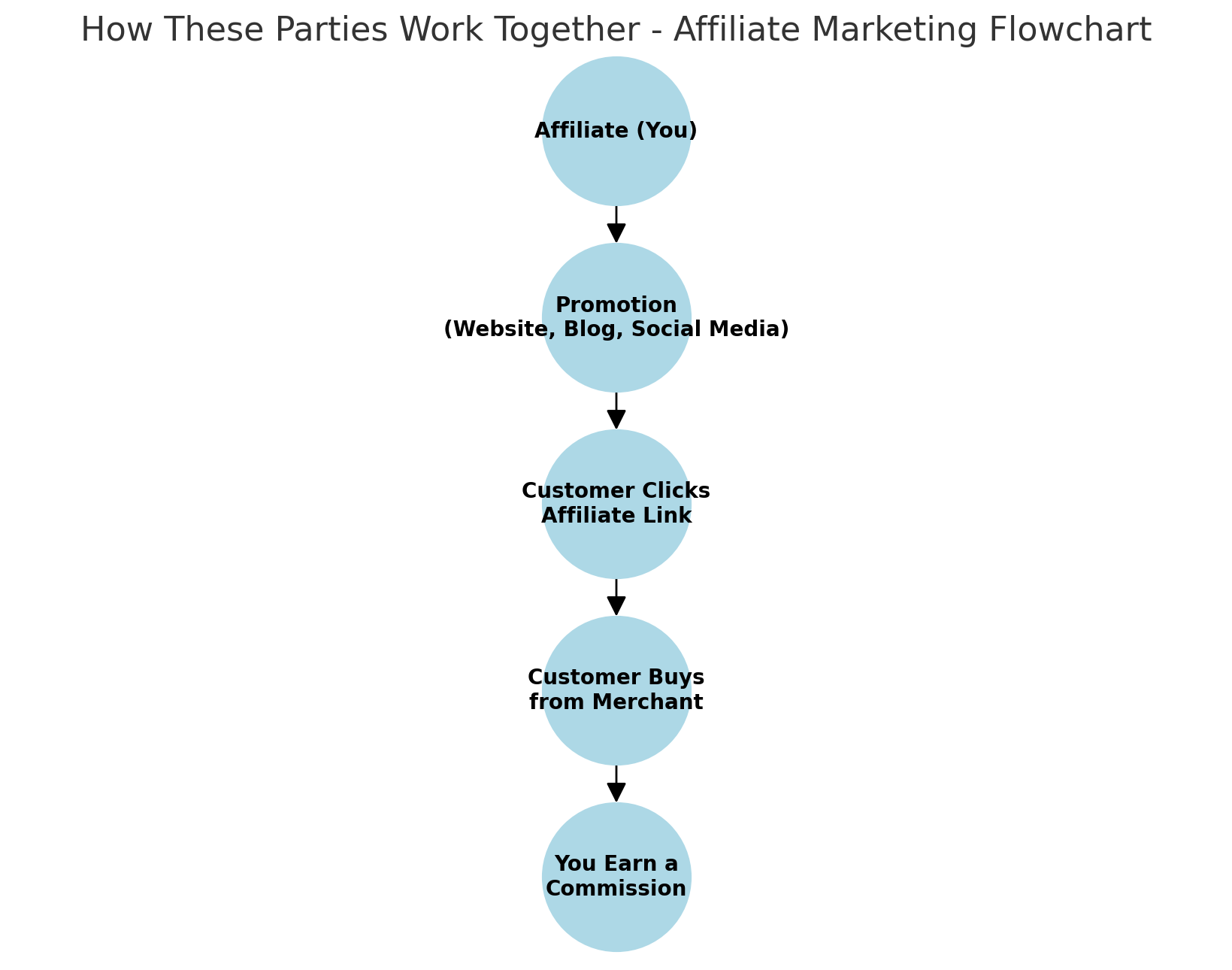
Step 2: Choosing Your Niche
Selecting the right niche is one of the most critical factors for success in affiliate marketing. Your niche determines what products you promote, your target audience, and ultimately how much money you can make. A well-chosen niche can help you build a sustainable business, while the wrong niche can make it difficult to gain traction.
What is a Niche in Affiliate Marketing?
A niche is a specialized market segment where you focus your affiliate marketing efforts. Instead of trying to promote everything, choosing a niche allows you to build authority in a particular area, attract a dedicated audience, and create content that converts.
How to Choose the Best Niche for Affiliate Marketing?
To select the best niche, consider the following factors:
- High Demand & Evergreen Potential – Pick a niche with consistent interest and growing demand.
- Your Passion or Expertise – Choosing a niche that aligns with your knowledge makes content creation easier.
- Profitability & Commission Rates – Ensure the niche has affiliate programs that offer good commission rates.
- Low Competition or Untapped Opportunities – Look for niches that have demand but are not overly saturated.
- Multiple Monetization Methods – The niche should offer various ways to make money, such as digital products, subscriptions, and services.
Top Affiliate Marketing Niches and Their Profit Potential
Best Tools to Validate Your Niche
- Google Trends (https://trends.google.com/) – Analyze search interest trends over the last five years.
- Ubersuggest – Research keyword volume and competition levels.
- Amazon Best Sellers – Identify popular product categories.
- ClickBank Marketplace – Explore high-paying affiliate products.
- SEMrush & Ahrefs – Check competition and keyword trends.
Pro Tip:
✅ Use Google Trends to ensure your niche is growing. Look for upward trends over the past five years rather than seasonal spikes.
✅ Pick a niche with multiple monetization options – digital products, courses, subscriptions, or services.
✅ Research affiliate programs before finalizing your niche. Some industries offer higher commissions than others.
Why Choosing the Right Niche Matters?
🚀 Increases Your Authority – People trust niche-specific experts more than generalists.
🚀 Boosts Search Engine Rankings – Google ranks authoritative niche sites higher.
🚀 Higher Conversion Rates – A focused audience is more likely to buy through your recommendations.
By carefully selecting the right niche, you’ll set a solid foundation for your affiliate marketing success. Now, let’s move on to finding the best affiliate programs!
Step 3: Finding the Right Affiliate Programs
Affiliate programs are platforms where affiliates sign up to promote products or services in exchange for a commission. Each program provides a unique referral link that helps track sales generated by the affiliate marketer. Choosing the right affiliate program is crucial to maximizing earnings and ensuring that you promote high-quality products that align with your niche and audience.
How to Choose the Right Affiliate Program
Not all affiliate programs are created equal. Here are some key factors to consider before signing up:
- Commission Structure – Look at how much you earn per sale (fixed rate vs. percentage-based commissions).
- Product Relevance – Ensure the products align with your audience and niche.
- Cookie Duration – A longer cookie duration means you get credited for sales even if the customer buys days or weeks later.
- Payout Threshold – Some programs require a minimum earnings threshold before you can withdraw funds.
- Payment Methods – Check if they support PayPal, bank transfers, or cryptocurrency payments.
- Program Reputation – Research online reviews to ensure legitimacy.
Best Affiliate Programs for Beginners
Here are some of the top affiliate programs, each offering unique advantages:
1. Amazon Associates
- Best for: Beginners and general product promotions.
- Commission Rate: 1% – 10% depending on the product category.
- Cookie Duration: 24 hours (if a user adds a product to their cart, you earn even after 90 days).
- Why Choose Amazon? Amazon has millions of products, making it easy to find something relevant to your audience.
2. ShareASale
- Best for: Bloggers, influencers, and niche marketers.
- Commission Rate: Varies by merchant.
- Cookie Duration: 30-90 days (depending on the merchant).
- Why Choose ShareASale? It connects affiliates with thousands of brands across multiple industries.
3. CJ Affiliate (Commission Junction)
- Best for: Advanced affiliates with a focus on brand-name promotions.
- Commission Rate: Varies by brand.
- Cookie Duration: 7-30 days.
- Why Choose CJ Affiliate? It provides access to premium brands and tools to optimize conversions.
4. ClickBank
- Best for: Digital products, courses, and software.
- Commission Rate: 30% – 70% (higher than most physical product affiliates).
- Cookie Duration: 60 days.
- Why Choose ClickBank? High commissions on eBooks, courses, and software subscriptions.
5. Impact Radius
- Best for: Influencers, bloggers, and content creators.
- Commission Rate: Varies by partner brands.
- Cookie Duration: 30 days.
- Why Choose Impact Radius? Used by big brands like Uber, Airbnb, and Adidas, offering competitive commissions.
6. Rakuten Marketing
- Best for: Established affiliates looking to work with top-tier brands.
- Commission Rate: Varies by retailer.
- Cookie Duration: 30 days.
- Why Choose Rakuten? A trusted global affiliate network with high-paying merchants.
7. eBay Partner Network
- Best for: Promoting trending or limited-time deals.
- Commission Rate: 1% – 6% per sale.
- Cookie Duration: 24 hours.
- Why Choose eBay Partner Network? High sales volume due to dynamic product listings and auctions.
Comparison of Affiliate Programs
Affiliate Program | Best For | Commission Rate | Cookie Duration |
Amazon Associates | Beginners | 1% – 10% | 24 hours |
ShareASale | Bloggers & Influencers | Varies | 30-90 days |
CJ Affiliate | Advanced Affiliates | Varies | 7-30 days |
ClickBank | Digital Product Promoters | 30% – 70% | 60 days |
Impact Radius | Large Brand Partnerships | Varies | 30 days |
Rakuten Marketing | Established Affiliates | Varies | 30 days |
eBay Partner Network | Product Deals & Auctions | 1% – 6% | 24 hours |
Additional Resources
If you’re interested in promoting business tools, check out MSME Government Schemes for small businesses, offering various incentives and support programs: 🔗 MSME Government Schemes
Choosing the right affiliate program depends on your niche, audience, and promotional strategy. Select programs that align with your interests and offer a sustainable income model for long-term success.
Step 4: Creating a Website or Blog
While social media can be a great starting point for affiliate marketing, having your own website or blog significantly increases credibility, improves search engine rankings, and provides a more sustainable source of traffic. A website acts as a central hub where you can create valuable content, review products, and integrate multiple affiliate links seamlessly.
Why Having a Website is Essential for Affiliate Marketing
✅ Credibility & Trust – A professional website builds trust with your audience and makes you look more authoritative.
✅ SEO Benefits – Your website can rank on Google, bringing in organic traffic without ongoing ad costs.
✅ Monetization Flexibility – Apart from affiliate marketing, you can earn from ads, sponsored posts, and product sales.
✅ Full Control Over Content – Unlike social media platforms that can change algorithms, your website remains your own property.
✅ Long-Term Passive Income – Well-optimized blog posts can continue generating revenue for years.
How to Set Up Your Website
Creating a website for affiliate marketing is easier than you think. Follow these simple steps to get started:
1. Buy a Domain Name
A domain name is your website’s address (e.g., www.yourwebsite.com). Choose a domain that is:
- Short and memorable
- Related to your niche
- Easy to spell and type
📌 Recommended Domain Registrars:
2. Choose a Hosting Provider
Web hosting stores your website’s files and makes them accessible online. Choose a hosting provider that offers: ✅ Fast loading speed (for better SEO and user experience) ✅ Strong security (to protect against hackers) ✅ Reliable uptime (so your site is always available)
📌 Recommended Hosting Services:
- Bluehost – Ideal for beginners, 1-click WordPress installation
- SiteGround – Fast and secure hosting
- Hostinger – Affordable and beginner-friendly
3. Install WordPress
WordPress is the most popular website builder for affiliate marketing because:
- It’s free and open-source.
- It offers thousands of themes and customization options.
- It supports SEO plugins to improve rankings.
📌 How to Install WordPress:
- Log in to your hosting dashboard.
- Look for the “1-Click Install” option.
- Select WordPress and follow the setup wizard.
- Choose your domain and complete the installation.
4. Pick a Theme & Design Your Site
Your website design should be clean, professional, and mobile-friendly. Choose a theme that: ✅ Loads fast ✅ Looks visually appealing ✅ Works well on mobile devices
📌 Recommended Free Themes:
- Astra – Lightweight and fast
- GeneratePress – Highly customizable
- Neve – Great for affiliate blogs
If you need a custom-designed professional website, check out Nova Vision Media Tech for expert web development services.
5. Start Posting Quality Content
Once your website is live, it’s time to create valuable content to attract visitors. Here are some high-performing content types:
📌 Product Reviews – In-depth reviews of products with affiliate links
📌 Comparison Articles – “Product A vs. Product B” guides
📌 How-To Guides – Tutorials on using a product
📌 Listicles – “Top 10 Best Laptops for Students”
📌 Case Studies – Real-life examples of a product’s effectiveness
Pro Tip: Use SEO strategies like keyword research, internal linking, and high-quality images to boost your rankings on Google.
Step 5: Generating Traffic to Your Affiliate Links
Your earnings depend on how much traffic (visitors) you drive to your affiliate links. Here are some effective methods:
1. Search Engine Optimization (SEO)
- Target long-tail keywords (e.g., “best digital marketing tools for beginners”).
- Optimize on-page elements (titles, meta descriptions, images, etc.).
- Build backlinks to increase authority.
- Improve page speed for better rankings.
2. Content Marketing
- Write detailed blog posts (like this one!).
- Create comparison articles (e.g., “Best Web Hosting Services Compared”).
- Publish reviews and tutorials.
3. Social Media Marketing
- Share affiliate links on Facebook, Instagram, and LinkedIn.
- Use Pinterest for niche blogging traffic.
- Start a YouTube channel to review affiliate products.
- Leverage TikTok for viral product reviews.
4. Paid Advertising
- Use Google Ads to target high-intent users.
- Promote via Facebook Ads and Instagram promotions.
Pro Tip: Use email marketing to build an audience and promote your links effectively

Step 6: Tracking & Optimizing Your Affiliate Strategy
To maximize your earnings in affiliate marketing, it is crucial to continuously track and optimize your strategy. By analyzing data and making improvements based on performance insights, you can boost conversions, increase traffic, and ultimately grow your income.
Why Tracking & Optimization is Important?
- Identifies What Works – Helps you focus on high-performing content and eliminate ineffective strategies.
- Improves Conversions – Optimization can increase the percentage of visitors who complete a purchase.
- Boosts ROI – Tracking allows you to invest more in channels that bring the highest returns.
- Reduces Wasted Effort – Ensures you don’t waste time promoting low-converting offers.
- Enhances User Experience – Understanding customer behavior helps you tailor content to their needs.
Best Tools for Tracking & Optimization
Using the right tools can help monitor your affiliate marketing efforts and make data-driven decisions.
1. Google Analytics – Track Website Traffic
Google Analytics is a powerful tool for understanding who visits your website, how they interact with your content, and what actions they take.
✅ Track page views, bounce rate, and session duration.
✅ Identify which blog posts or landing pages drive the most traffic.
✅ See where your visitors are coming from (organic search, social media, referral, etc.).
✅ Analyze conversion rates to measure sales generated from affiliate links.
📌 Pro Tip: Set up goals and conversion tracking in Google Analytics to monitor when visitors complete an action, such as clicking an affiliate link.
2. Bitly – Shorten & Track Links
Bitly is a URL shortener that also provides real-time tracking of link clicks.
✅ Shorten long affiliate URLs to make them look clean and professional.
✅ Track the number of clicks on each affiliate link.
✅ See the geographic location and devices of users clicking your links.
📌 Pro Tip: Use custom Bitly links with meaningful names (e.g., bit.ly/best-laptop-deal) to increase trust and click-through rates.
3. UTM Parameters – Track Conversions from Different Channels
UTM parameters are tags added to the end of URLs that help you track where your affiliate traffic is coming from.
✅ Helps differentiate traffic sources (e.g., Facebook ads vs. Instagram posts).
✅ Allows you to identify which campaigns are driving the most conversions.
✅ Provides detailed insights inside Google Analytics.
📌 Example: Regular URL: https://example.com/product
UTM Tracked URL: https://example.com/product?utm_source=facebook&utm_medium=post&utm_campaign=affiliate
Use Google’s Campaign URL Builder (https://ga-dev-tools.web.app/campaign-url-builder/) to create UTM-tagged links easily.
4. A/B Testing – Compare Different Strategies
A/B testing (also known as split testing) is the process of testing two different versions of content to see which performs better.
✅ Test different headlines, call-to-action buttons, and images.
✅ Experiment with email subject lines and landing page layouts.
✅ Optimize ad copies to determine which gets the best response.
📌 Pro Tip: Only test one variable at a time to accurately determine what causes performance differences.
Earnings Potential Chart
By tracking and optimizing your affiliate marketing strategy, you can significantly increase your earnings. Below is an estimated earning potential chart based on different marketing methods:
Strategy | Earnings Potential (Per Month) |
Blogging | $500 – $10,000 |
YouTube | $1,000 – $20,000 |
Email Marketing | $500 – $50,000 |
Social Media | $100 – $5,000 |
Paid Ads | $500 – $15,000 |
📌 Pro Tip: Diversify your income streams by using multiple strategies (e.g., combining blogging with email marketing) to increase revenue potential.
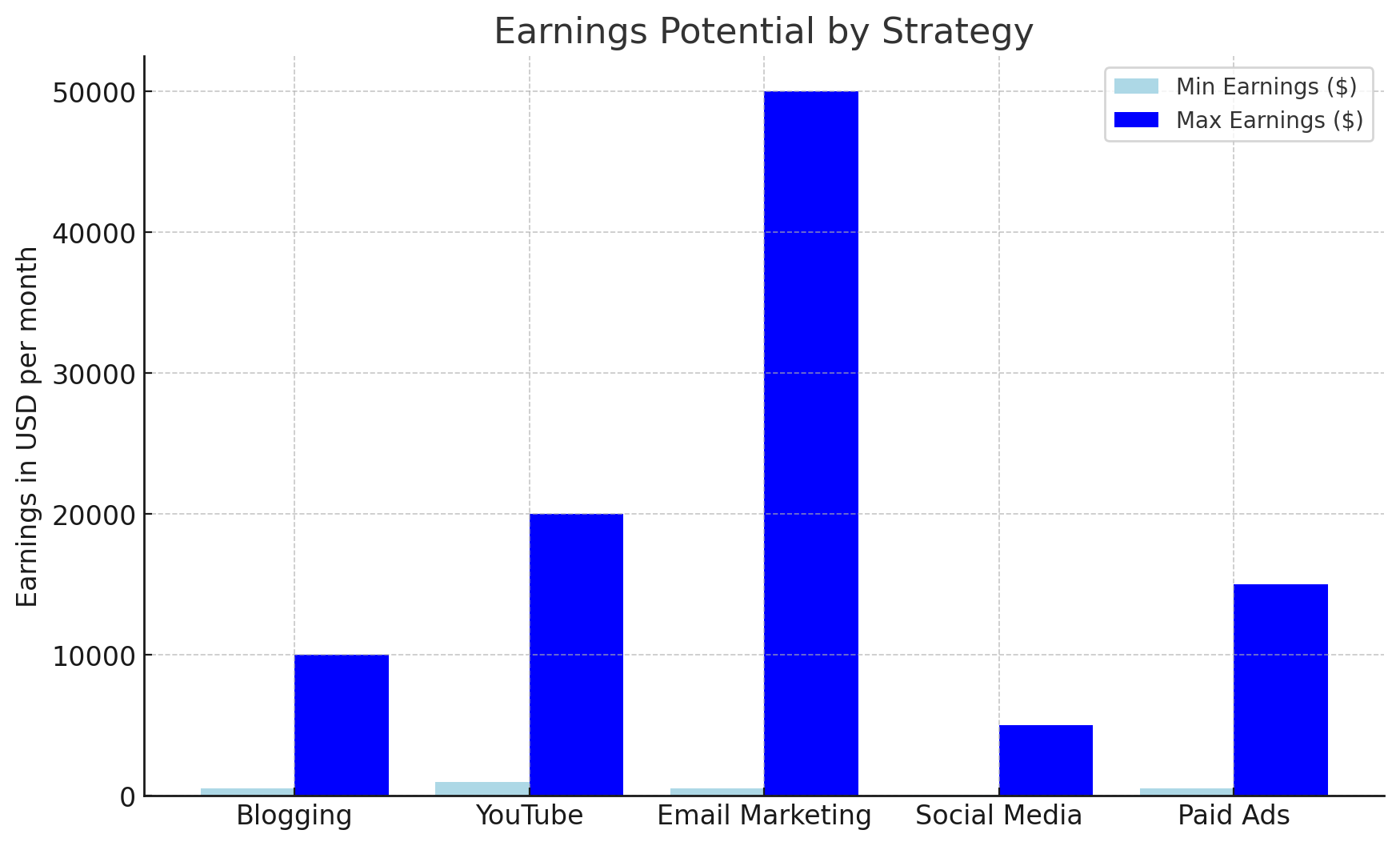
Step 7: Scaling Up Your Affiliate Business
Once you start earning commissions consistently, the next step is scaling up your affiliate marketing business to maximize revenue and build long-term sustainability. Scaling requires implementing automation, expanding into new niches, and optimizing traffic sources to increase conversions. Here’s how you can take your affiliate marketing business to the next level:
1. Automate Email Marketing for Higher Conversions
Email marketing is a powerful tool to drive repeat traffic and increase conversions. Rather than manually sending emails, you can automate your email campaigns using tools like Mailchimp, ConvertKit, or AWeber. Here’s how automation helps:
- Nurtures leads – Send automated follow-ups to potential buyers.
- Boosts conversions – Share product recommendations and personalized offers.
- Reduces manual effort – Once set up, email sequences work on autopilot.
2. Hire Freelancers for Content Creation
As your business grows, consistently publishing high-quality content is essential. However, creating blog posts, videos, or graphics alone can be time-consuming. Consider outsourcing content creation to freelancers on platforms like Fiverr, Upwork, or Freelancer. You can hire:
- Writers – To create engaging blog posts and product reviews.
- Graphic designers – To design social media posts and infographics.
- Video editors – To enhance YouTube and TikTok video content.
Pro Tip: Set clear guidelines for freelancers to maintain content quality and brand consistency.
3. Expand into New Niches
Once you establish a strong presence in one niche, diversify into new markets to increase revenue streams. Expanding into multiple niches reduces dependency on a single source of income.
For example:
- If you started with tech gadgets, you could expand into software tools or online courses.
- If you focused on fitness, consider adding nutrition and wellness products.
Pro Tip: Use Google Trends to find trending and profitable affiliate niches.
4. Invest in SEO and Paid Traffic
Organic traffic through SEO (Search Engine Optimization) is a long-term asset. However, to accelerate growth, invest in paid advertising to drive targeted traffic quickly.
- SEO Strategies to Scale Up:
- Target high-value keywords with buyer intent.
- Improve page speed and mobile optimization.
- Build high-quality backlinks from authoritative sites.
- Paid Traffic Strategies:
- Use Google Ads to target users actively searching for your affiliate products.
- Leverage Facebook & Instagram Ads to reach new audiences.
- Experiment with YouTube Ads for visual engagement.
Pro Tip: Always track and analyze paid ad performance to optimize your budget and ROI.
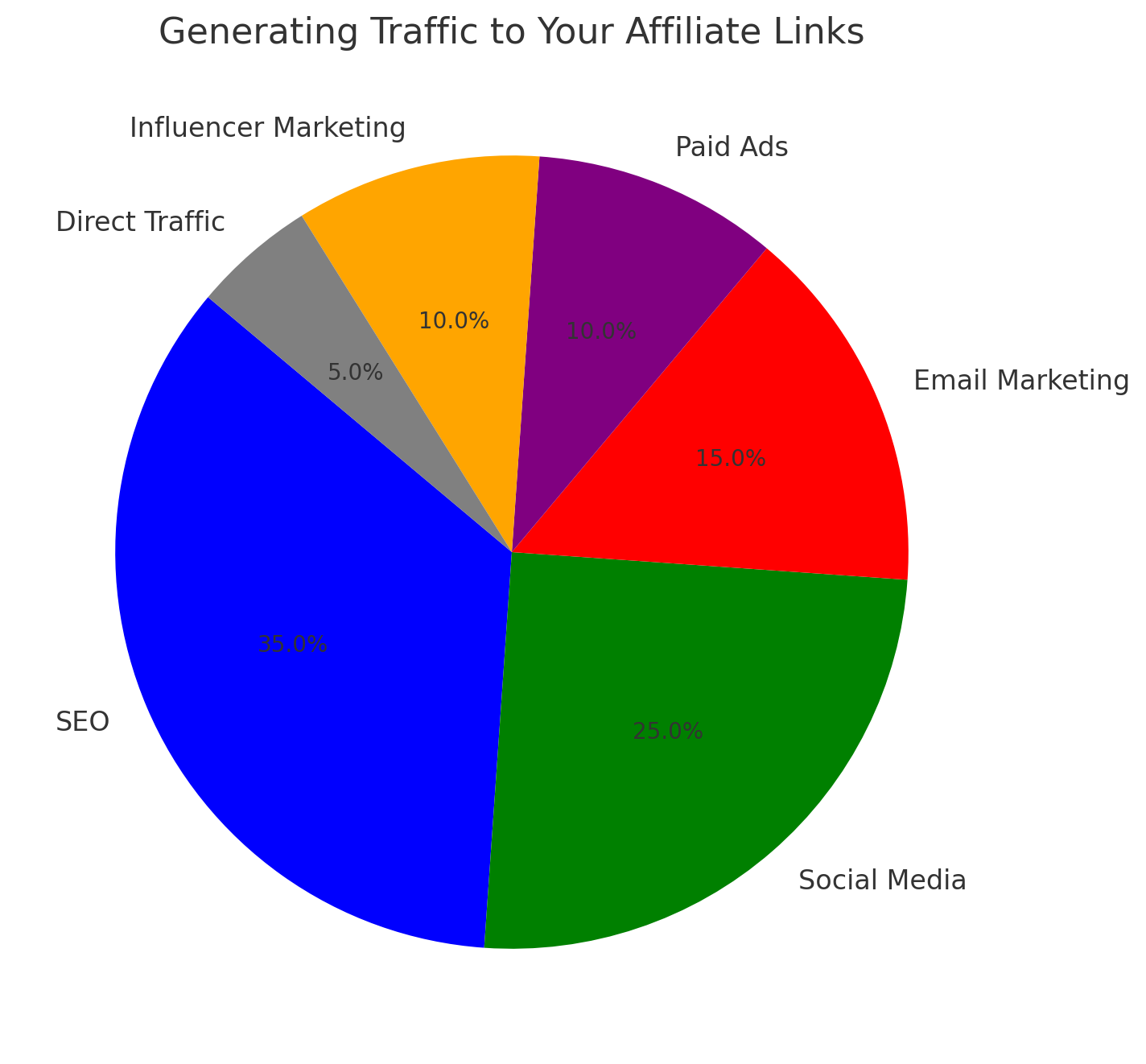
Common Mistakes to Avoid When Scaling
Scaling your affiliate marketing business can be highly rewarding, but many affiliates make critical mistakes that slow their growth. Avoid these pitfalls:
❌ Promoting Too Many Products at Once – Focus on high-converting products instead of overwhelming your audience with too many choices.
❌ Ignoring SEO and Keyword Research – Organic traffic is free and sustainable; neglecting SEO can limit your long-term success.
❌ Not Testing Different Strategies – A/B test different content formats, CTAs, and promotional strategies to find what works best.
❌ Depending on a Single Traffic Source – Diversify traffic sources (SEO, social media, email, and paid ads) to avoid sudden drops in revenue.
Scaling Chart: Organic vs. Paid Growth Strategies
Growth Strategy | Organic Scaling | Paid Scaling |
Content Marketing | ✅ Yes | ❌ No |
SEO Optimization | ✅ Yes | ❌ No |
Social Media Traffic | ✅ Yes | ✅ Yes |
Email Marketing | ✅ Yes | ✅ Yes |
Paid Ads (Google, FB) | ❌ No | ✅ Yes |
Scaling an affiliate marketing business requires patience, strategic planning, and consistent execution. By automating key processes, expanding into new niches, leveraging SEO, and optimizing paid ads, you can significantly increase your affiliate earnings.
Key Takeaways for Success in Affiliate Marketing:
- Choose a Profitable Niche: Selecting the right niche is crucial. Focus on topics that align with your interests and have high earning potential. Research industry trends, search volume, and commission rates before making a decision.
- Join Reputable Affiliate Programs: Partner with well-known and reliable affiliate networks such as Amazon Associates, ShareASale, CJ Affiliate, or specialized high-paying programs that align with your niche.
- Drive Traffic Using SEO and Content Marketing: Build a website or blog that ranks on search engines. Use keyword research, high-quality content, and backlink strategies to attract organic traffic and increase conversions.
- Leverage Social Media & Paid Advertising: Social media platforms like Instagram, TikTok, and Pinterest can help you reach a broader audience. Additionally, investing in paid advertising (Google Ads, Facebook Ads) can help accelerate your affiliate sales.
- Track and Optimize Performance: Use Google Analytics, Bitly, UTM tracking, and A/B testing to analyze what works best and optimize your strategies accordingly.
- Expand and Scale Up: Once you start earning commissions, reinvest in scaling your affiliate business by automating marketing strategies, outsourcing content creation, and expanding into new niches.
The Power of Passive Income with Affiliate Marketing
Affiliate marketing allows you to create a sustainable and scalable income stream. Unlike traditional jobs, where income is directly tied to hours worked, affiliate marketing enables you to earn money even while you sleep—as long as your content and strategies are in place.
Realistic Expectations & Challenges
While affiliate marketing has great potential, it’s important to maintain realistic expectations. Success doesn’t happen overnight. It requires:
- Patience – Earnings grow over time as your audience and credibility increase.
- Consistency – Regular content updates and marketing efforts are necessary.
- Adaptability – The digital landscape is constantly changing, and staying updated with trends is key.
Why Now is the Best Time to Start?
The affiliate marketing industry is expanding rapidly, with businesses investing more in digital partnerships. With AI-driven content tools, improved analytics, and increasing e-commerce opportunities, this is the perfect time to build a profitable affiliate business.
Need help building your affiliate marketing website? Contact us at Nova Vision Media Tech for expert guidance on website design, SEO, and content strategy to help you get started.
By implementing these proven strategies, you’ll be on the right path to creating a successful affiliate marketing business and achieving financial freedom. Happy earning!
Conclusion
Starting affiliate marketing with no prior experience is absolutely achievable if you follow the right approach and strategies. This business model provides an excellent opportunity for individuals looking to earn passive income online, without requiring a significant investment.


